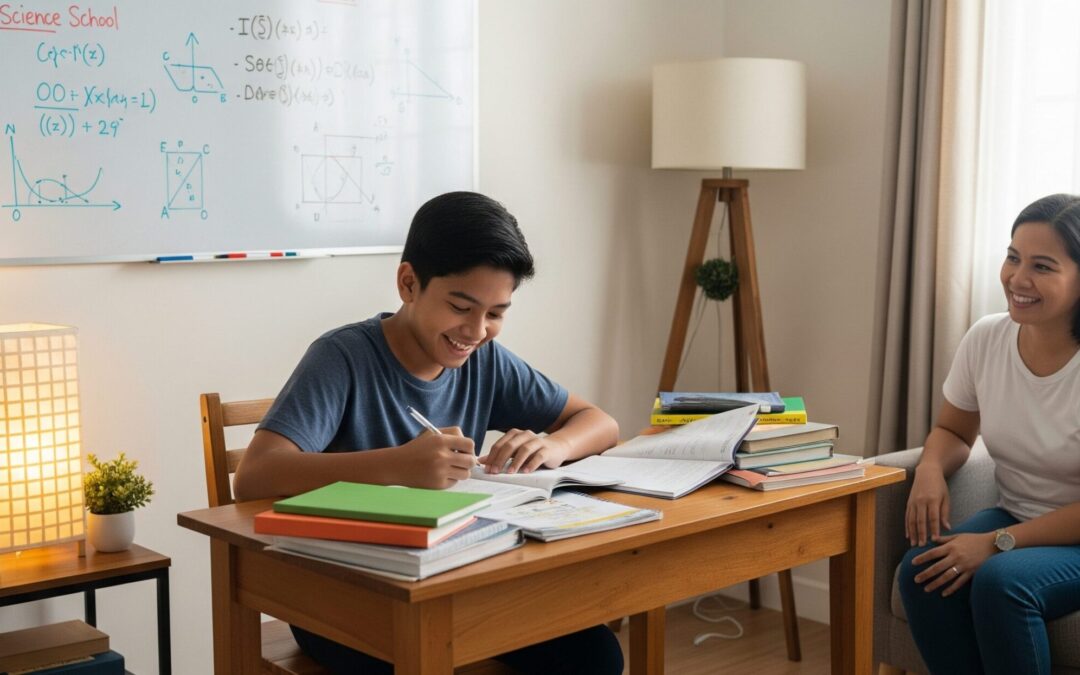For many Grade 6 students, moving up to junior high school isn’t just about a new campus and new friends. It also means preparing for entrance tests that can open doors to some of the country’s best schools. For parents, it’s a mix of excitement and nerves as they help their children gear up for this big milestone.
The good news? With the right preparation, entrance exams don’t have to be intimidating. Here are five tried-and-tested tips that will help students (and parents) feel more confident come exam day:
1. Know What to Expect in the Exam
Most entrance tests cover core subjects such as English, Math, and Science, plus logical or abstract reasoning. Some schools, like Philippine Science High School (PSHS), focus heavily on scientific ability, quantitative skills, abstract reasoning, and verbal aptitude through the National Competitive Examination (NCE).
Why it matters: If your child knows the coverage and style of questions early on, you can plan the review sessions better. It’s like studying with a map instead of going in blind.
2. Create a Study Routine that Works
Instead of cramming the night before, encourage your child to review a little every day. According to the American Psychological Association, “distributed practice” (spacing out study sessions) improves long-term learning far more than cramming.
Practical tip: Start with a manageable schedule—maybe 1 to 2 hours a day—then adjust as the exam approaches. Mix in reading, practice drills, and discussions so studying doesn’t feel like a chore. Parents can also help by making a quiet, distraction-free study space at home.
3. Practice with Mock Tests
Entrance exams are often timed, which can pressure even the brightest students. Taking simulated tests helps build speed, accuracy, and confidence. Research shows that practice tests are one of the most effective study strategies because they strengthen recall and problem-solving under pressure.
Practical tip: Time your child while they take mock exams. Afterward, review mistakes together and talk through solutions. This not only builds skills but also reduces test-day anxiety.
4. Don’t Forget Health and Wellness
A sharp mind needs a healthy body. The Centers for Disease Control and Prevention (CDC) reminds parents that children need 8–10 hours of sleep per night, nutritious meals, and regular exercise to perform well academically.
Practical tip: Encourage balanced meals, plenty of water, and downtime for rest or play. A healthy child is more focused, less stressed, and better prepared to absorb lessons.
5. Consider Enrolling in a Trusted Review Center
Sometimes, parents and students need extra guidance, especially for competitive schools. That’s where review centers come in. They provide structure, expert coaching, and high-quality materials tailored to the exams. Students also gain confidence knowing they’re practicing with proven methods.
For example, AHEAD’s Junior High School Review is specially designed to prepare Grade 6 students for the country’s most competitive schools, including Philippine Science High School. The program includes signature diagnostic and simulated tests, along with materials that sharpen scientific, quantitative, reasoning, and verbal skills, all essential for passing the NCE. Check AHEAD’s website to see their schedules and rates.
Preparing for junior high school entrance tests is a team effort between students and parents. By knowing the exam coverage, building consistent study habits, practicing with mock tests, staying healthy, and getting expert support through a review program, Grade 6 students can walk into the exam room feeling ready and confident.
With the right preparation and mindset, this big step can be an exciting milestone, one that sets the stage for future success.
Sources:
American Psychological Association. (nd). Distributed practice definition. Retrieved from https://dictionary.apa.org/distributed-practice
Centers for Disease Control and Prevention. (2017). Sleep in middle and high school students. Retrieved from https://www.cdc.gov/healthyschools/features/students-sleep.htm
Mirjam Sophia Glessmer. (2022). Effective learning techniques for students: Currently reading Dunlosky et al. (2013). Retrieved from https://mirjamglessmer.com/2022/05/15/effective-learning-techniques-for-students-currently-reading-dunlosky-et-al-2013/
Philippine Science High School System. (n.d.). National competitive examination FAQs. Retrieved from https://pshs.edu.ph/nce-faqs/
